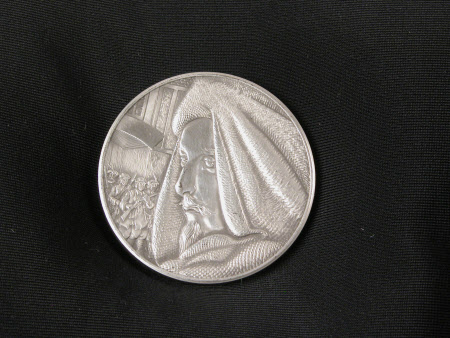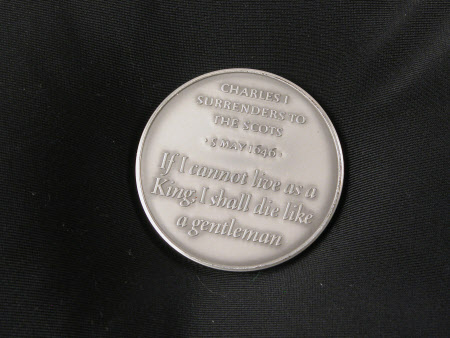Charles I Surrenders to the Scots
John Lobban (1919-1996)
Category
Coins and medals
Date
1993
Materials
SIlver
Measurements
517 mm (Diameter)
Place of origin
United Kingdom
Order this imageCollection
Osterley Park and House, London
NT 773256
Summary
Silver, The Surrender of Charles I to the Scots, medal designed by John Lobban (1919-1996) and Michael Harvey (1931-2013), struck Royal Mint, Llantrisant, 1993. A silver medal commemorating the surrender of King Charles I to the Scots, on 5 May 1646. The ninth medal in a set of twelve issued by the Royal Mint in 1992 and 1993, to mark the 350th Anniversary of the English Civil War. The obverse, designed by John Lobban, depicts King Charles in the disguise that he was forced to don as he made his way from Oxford to Newark. A group of Scottish soldiers at left, outside a building representing Kelham House, where the King resided whilst in the custody of the Scots. Artist’s monogram 'JL' at lower left. The legend on the reverse, designed by Michael Harvey, reads: 'CHARLES I SURRENDERS TO THE SCOTS. / 5 MAY 1646. / If I cannot live as a King, I shall die like a gentleman'. The latter phrase is taken from a letter written by the king on 26th March 1646 to Lord Digby.
Full description
The Civil War was fought, mainly in England, between 1642 and 1649, the result of a long struggle for power between King Charles I (1600-49) and Parliament. As the Royalist cause became ever more hopeless after the defeat at Naseby, Charles realised that he had to escape from the Royalist capital Oxford, which seemed certain to fall to Fairfax’s forces. On 26 April 1646, he left Oxford secretly and in disguise, making his way by a circuitous route to Newark, where the Scottish Covenanter forces were camped. Charles had thought that he was likely to obtain the best terms from the Scottish Presbyterians, so surrendered to them on 5 May. However, he refused to accept their demands, which included the signing of the Presbyterian Covenant and the establishment of Presbyterianism in England and Ireland. The Scots decided therefore to hand Charles over to the English Parliamentarian forces. This was the ninth in a series of twelve medals issued by the Royal Mint at monthly intervals from June 1992, to celebrate the 350th anniversary of the outbreak of the English Civil War. The twelve medals illustrate the significant points in the conflict, from the raising of Charles I’s standard at Nottingham on 22 August 1642, to his execution on 30 January 1649. The designs of the obverses of the medals were commissioned from three leading contemporary artists, John Lobban, Michael Rizzello and Avril Vaughan, whilst the reverses, each of which contains a quotation relating to the subject of the medal, were designed by the distinguished lettering artist Michael Harvey, best-known for the names of celebrated Renaissance artists carved into the stonework of the Sainsbury Wing of the National Gallery. Michael Harvey’s original artwork for the series is in the Library of the University of Reading (URL MS 5115, file 392). The selection of the twelve episodes and the accompanying legend was devised by the historian of Tudor coinage Dr Christopher Challis. The medals were issued in silver and in bronze, in editions of 2,500 and 5,000, retailing at £84.50 or £49.50 per medal respectively. It was possible to buy the medals singly or as a set of twelve, the latter housed in an African walnut case. The whole series is in the collection at Osterley, but without the wooden case (NT 773248-773258, NT 773623). Jeremy Warren 2019
Provenance
Given to the National Trust in 1993 by George Child Villiers, 9th Earl of Jersey (1910-1998).
Marks and inscriptions
Obverse, lower left: JL (John Lobban monogram) Reverse, legend: CHARLES I SURRENDERS TO THE SCOTS. / 5 MAY 1646. / If I cannot live as a King, I shall die like a gentleman
Makers and roles
John Lobban (1919-1996), designer Michael Harvey (1931-2013), designer The Royal Mint, manufacturer

